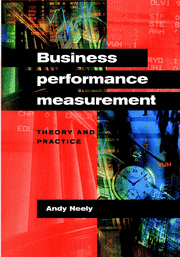Book contents
- Frontmatter
- Contents
- List of contributors
- Preface
- Part I Performance measurement – functional analyses
- 1 Measuring performance: The accounting perspective
- 2 Measuring performance: The marketing perspective
- 3 Measuring performance: The operations perspective
- 4 Finding performance: The new discipline in management
- Part II Performance measurement – theoretical foundations
- Part III Performance measurement – frameworks and methodologies
- Part IV Performance measurement – practical applications
- Part V Performance measurement – specific measures
- Part VI Performance measurement – emerging issues and trends
- Index
2 - Measuring performance: The marketing perspective
from Part I - Performance measurement – functional analyses
Published online by Cambridge University Press: 06 July 2010
- Frontmatter
- Contents
- List of contributors
- Preface
- Part I Performance measurement – functional analyses
- 1 Measuring performance: The accounting perspective
- 2 Measuring performance: The marketing perspective
- 3 Measuring performance: The operations perspective
- 4 Finding performance: The new discipline in management
- Part II Performance measurement – theoretical foundations
- Part III Performance measurement – frameworks and methodologies
- Part IV Performance measurement – practical applications
- Part V Performance measurement – specific measures
- Part VI Performance measurement – emerging issues and trends
- Index
Summary
Introduction
Assessing marketing performance is an increasingly important task for managers and other corporate stakeholders. First, many firms are looking to provide fresh growth in profit through increasing sales after years of downsizing (Sheth and Sisodia, 1995). Second, multi-disciplinary perspectives on performance measurement, such as the balanced scorecard (Kaplan and Norton, 1992) are increasing the attention given to non-financial measures of performance in general, raising the issue of which marketing measures, if any, should be included in such schemes. Third, investors and analysts are increasingly asking for information on the marketing performance of firms (Haigh, 1998; Mavrinac and Siesfeld, 1997).
Unfortunately, assessing marketing performance is also very difficult to do. Unlike purely internal measures of performance, such as defects per million, marketing performance depends on external, largely uncontrollable actors, such as customers and competitors. Further, it acts as a mediator between these external actors and various internal corporate processes, such as accounting, manufacturing, research and development, and finance. Bonoma and Clark (1988, p. 2) observe that these factors make “marketing's outputs lagged, multivocal, and subject to so many influences that establishing causes-and-effect linkages is difficult.”
This contribution is intended to introduce the reader to the long history of measuring the performance of marketing, reviewing representative samples of each research tradition. I begin with a discussion of the marketing productivity paradigm, which dominated much of the first 40 years of work in this area, and move on to illustrate expanded conceptions of marketing outputs and inputs, particularly in the distinction between marketing activities and assets.
- Type
- Chapter
- Information
- Business Performance MeasurementTheory and Practice, pp. 22 - 40Publisher: Cambridge University PressPrint publication year: 2002
- 7
- Cited by



